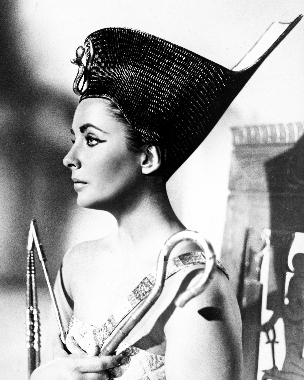In the iconic 1963 photograph of Elizabeth Taylor as Cleopatra on the set of Cleopatra, the image of the Egyptian Queen reflects the modern interpretation of her legendary beauty while also preserving her authentic ancient iconography.
Like Cleopatra, Elizabeth Taylor was thought to be one of the most beautiful women that ever lived. The choice to use Taylor to play Cleopatra shows that the public idea of Cleopatra has come to be synonymous with ethereal beauty. When we see this picture of Taylor with her exquisite eyes and dark hair, holding the crook and flail, there is no question as to who she represents. The mythos of the great beauty of these two women is so engrained in our culture that the two are now immutably linked in the collective consciousness of the Western World. The classical iconographies used in this image of Cleopatra are the headdress with a snake on the front of it and the crook and flail sceptres held across the chest. These insignias were used by the pharaohs and are easily recognised symbols for the modern audience. They are being used in this image to show that Cleopatra is regal, powerful, formidable and eternal. Together, the modern ideal of beauty and the ancient Egyptian iconographies of the headdress and sceptres form an image of Cleopatra that continues to evolve as her story slips further from history and deeper into mythology.

